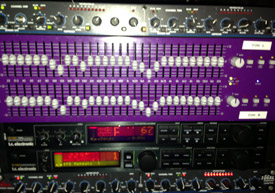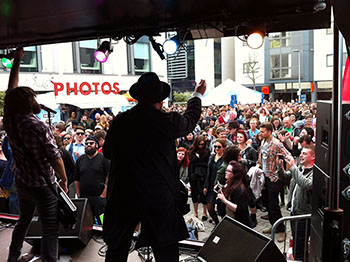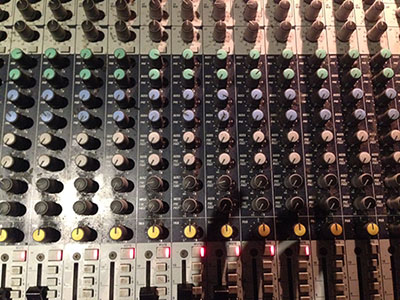The importance of EQ on your fold-back and floor monitor system in a live show
Posted: 10 August 2015
Synopsis: Feedback can destroy a show. It can distract the performers, annoy the audience and ruin even the best sounding mix. In reality, most feedback is actually generated on stage, through the foldback /monitor system via the vocal and instrument microphones. T

PART 1 -Your Monitor System
We all dislike feedback, unless you are in Sonic Youth. But even they don't like feedback from their vocal mics that is caused by a poor monitor tuning. We have all heard this type of feedback, a persistent low end rumble, or a mid range honk and the most annoying high frequency squeals, all of which has the potential to ruin a performance. It can distract the performer, and effect the hearing of both the audience and the people on stage. Prolonged feedback will also damage your speakers, increasing likelihood of blowing horns.
The question is how to prevent this from occurring. The answer is to use an Equaliser, known as an EQ over each "send" of audio. This 3 part series of blogs is designed to explain the art of EQ'ing a fold back/monitor system so you can get the best results from your system. The first part will go through some basic terminology so you can understand exactly what we are dealing with and will then provide a quick run through of how to set up a typical monitor system with the EQ. The second part will explain how to use an EQ, whilst the final part will discuss how to EQ for different vocal microphone techniques used by singers. At the end of blog series, you will have the background knowledge to get your monitor system sounding as crystal clear as possible.
|
A monitor system, is comprised of foldback or stage floor monitors, either self powered (active, with in built power amp) or non powered (passive, requiring an external power amp). Signal is sent to these speakers from a mixing desk that feeds into an Equaliser which is external to the desk if it is analogue, or often internal when using a digital desk, before proceeding to the speakers. |
 Klark-Technik Square One Graphic Equaliser |
 The Beards at the Great Escape Festival in England. See the "Wedges"? |
Foldback speakers / stage floor monitors or "wedges" are speakers that are placed on stage, pointing back at the performers. Their purpose is to provide a means by which performers can hear themselves, and each other on stage during their performance so they don't make mistakes and can hear relative cues that they require. Most monitor systems will be set up so the vocalist can hear what they are singing, by amplifying their voice to balance with the levels of the band they are playing in. |
|
The most common foldback system comprises 4 speakers, placed on the floor, angled up toward the singers and musicians. Usually there will be 3 placed equal distance apart at the front of the stage, and one placed next to the drummer. An audio signal is delivered into these speakers through AUX outputs on the mixing desk. Depending on the desk capabilities, a standard set up for a rock band will use 4 sends from the desk, with each speaker on a single send. In other words if your desk has 4 AUX outputs,one aux output will go to one individual speaker. This send arrangement allows for a separate mix on each foldback speaker. |
 Village People at Golden Plains Festival 2015. Note the foldback speaker set up. |
 A typical analogue mixing console, featuring the AUX section on the board. |
Each input channel on the desk (I.e, kick, snare,bass, keyboard, vocal) will have AUX level knobs, usually positioned below the EQ section on the channel. By adjusting these knobs, control over the amount of level of each instrument being sent to the foldback can be controlled. For example if vocal 1 wants is standing in front of the foldback speaker connected to AUX send 1 wants to hear more of his/her vocal, no guitar but lots of keyboard, you would go the the AUX 1 knob on his/her vocal channel and turn it up, then the guitar channel and make sure AUX 1 is turned down, and keyboard channel AUX 1 turned up. You can repeat the process for all individual AUX sends. |
However, what happens if it's really loud on stage, and the vocalist needs to hear more of their vocal mic, but when you turn it up, it starts to feedback? How do you overcome this problem?
Part 2 of our blog series will address this issue by first explaining what feedback is, how it arises and how we can stop it through the use of an EQ. We will look at how to set up the Equaliser and explain the basic concepts behind using it most effectively in a live situation.
As with any of our blogs, please feel free to comment, make suggestions and ask any questions you may have.
Happy mixing!
Stu!













